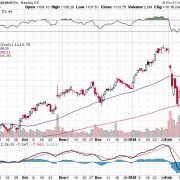If you think America has a blue collar jobs problem you haven’t seen anything yet. That’s if Alphabet (GOOG) has anything to say about it.
It turns out that the future is coming a lot faster than anyone expected.
Waymo, the top-secret Alphabet autonomous driving subsidiary, has beaten all comers to the punch. The desert state of Arizona has granted a permit for it to commence with their autonomous fleet as a commercial entity in 2018.
This permit means that Waymo’s futuristic robo-taxi can charge passengers for profit. The vehicles started testing in 2017 and were monitored with a human safety engineer inside. This is a big deal from a regulatory point of view.
It took nine years of diligent preparation to arrive at this momentous announcement.
First mover advantage is pivotal in dictating an agenda and setting the rules of the road in the world of innovation.
The desperation of being first to market was epitomized by an email that former top engineer, Chris Urmson, sent Alphabet founders, Larry Page and Sergey Brin, “We have a choice between being the headline or the footnote in history’s book on the next revolution in transportation. Let’s make the right choice.”
In 2018, Waymo has chosen to be the headline after a flurry of lawsuits. The private ride sharing service Uber felt the only way to claw its way back from the abyss was to poach Waymo’s top dogs and steal their trade secrets. It didn’t work.
The war isn’t over, but it will be hard press for other companies to dampen Waymo’s momentum.
Waymo, a subsidiary of Alphabet (GOOG), is the preeminent force in the quest for mass market driver-less vehicles.
Before Waymo was coined, Google's self-driving-car research was an internal program referred to as Project Chauffeur. The project was created in 2009, hidden from the public eye to keep its technology safeguarded from intruders.
Alphabet invested at least $1.1 billion between 2009 and 2015 to grab the undisputed lead position of this newly created industry.
Most observers estimate that commercialization of level 4 self-driving vehicles will occur sometime around 2020. However, Waymo is not most companies.
The time sensitivity is palpable as Waymo has a chance to flood American streets with its technology before GM (GM) or Uber can get off the starting blocks.
Waymo out-muscled its opponents, reaching a Level 3 standard in 2012. Level 4 is the grade that automakers wish to proceed with. Although not fully Level 5 automated, Level 4 technology can operate under controlled factors without a driver.
The Fiat Chrysler minivans tricked out with Waymo technology have been racking up test miles in Phoenix, Arizona to the tune of around 5 million on Level 4 technology.
Arizona has been a fertile breeding ground for driver-less car development since 2015, when Governor Doug Ducey signed an executive order giving authority to state agencies to “undertake any necessary steps to support the testing and operation of self-driving vehicles on public roads within Arizona.”
The success or failure in Arizona will go a long way to test the quality and sustainability of this new phenomenon. It helps a lot that Phoenix streets are laid out in a simple grid that the current level of artificial intelligence find easy to recognize and understand.
The Waymo lawsuit has subdued competitor Uber for the moment in this zero-sum game. In fact, Waymo’s progress represents an existential threat to Uber.
Waymo is essentially Uber with no driver. Drivers cost money. Waymo hopes to remove the highest input in ride sharing transport - the driver itself.
In just the last quarter, Uber shelled out around $8 billion to drivers equating to around 72% of quarterly gross revenue. No wonder Uber is running in the red and and losing sleep over every Waymo headline they read.
Waymo plans to expand its coverage to other locations. During the last earnings call, Google CFO Ruth Porat noted “We do continue to explore a range of options beyond the program we’re piloting in Phoenix, including, ride sharing and personal use vehicles, logistics, deliveries, and working with cities to help them address public transportation objectives.”
The first commercial operation will begin shortly in Arizona and is crucial to harmonize consumer sentiment with reliable driver-less vehicles. The accumulated data will be vital to prove Waymo’s safety record. If all goes smoothly, Waymo’s autonomous vehicles and technology will spread like wildfire to other locations.
NuTonomy is the only other autonomous vehicle maker that hopes to monetize its efforts in 2018. General Motors (GM) is on course to come on line in 2019, contingent on the permit they applied for. The Uber vs Waymo litigation guarantees that Uber will be squarely in the rear-view mirror.
The potential success will fundamentally change the way people live their lives.
Up to 10 million employed drivers are set to be on the chopping block in America. That includes about 3.5 million professional truck drivers who earn between $30,000-$45,000 per year, along with 2 million Uber/Lyft drivers participating in the gig economy at $7.25 an hour.
The mass adoption of autonomous vehicles will eliminate a huge hunk of the American workforce, while redrawing additional income streams to Alphabet (GOOG).
Insurance companies would take a direct hit with the future pipeline of drivers irrevocably thwarted from learning how to drive. If the preliminary data comes up roses, parents will not allow their 16-year-old kid to learn how to drive. Also, the tragic 40,000 annual fatalities caused by motor vehicle crashes will drop off a cliff.
The pick up in productivity would be astounding as workers will no longer need to drive themselves anymore, cutting costs, and allowing additional time to work while in transit.
The unintended consequences will change the world while making the leaders of the space richer. A deeper underlying effect is that it will strengthen (GOOG)’s credentials going forward to apply A.I. in other spheres.
The peer group is comprised of NuTonomy's technology, second only to Waymo in terms of ability and has been undergoing rigorous trials in Singapore since 2016.
Rounding out the top 3 in this trio is (GM) who is patiently waiting for permission to begin operating its fully autonomous fleet in a commercial ride-hailing service in 2019.



